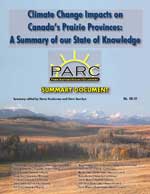Impacts & Adaptation Highlights
For The World, The Prairie Provinces and Saskatchewan
Climate change research is being conducted all around the world. Much of the current public debate is concerned with reducing or mitigating greenhouse gas emissions, which are one of the major contributors to climate change. However, even if greenhouse gas emissions were significantly reduced the effects of climate change are already being experienced and will persist into the future. Therefore research that addresses how climate change impacts us as well as how we might adapt is necessary to assist us to live and thrive under climate change.
The World - Intergovernmental Panel on Climate Change (IPCC) 

Climate change and its impacts affect global regions differently. For example, Canada's North is expected to experience the greatest level of warming and associated impacts, as the permafrost level drops and extent of ice cover is reduced. The United Nations (UN) established an Intergovernmental Panel on Climate Change, better known as the IPCC to lead an international effort on assessing climate change. The latest report of the IPCC is its Fourth Assessment prepared in 2007 (Figure 1).
The Prairie Provinces - Prairie Adaptation Research Collaborative (PARC) 
Over the past three years PARC has been involved in several major projects that have assessed climate change impacts and adaptations within the prairie provinces.
The first project is an assessment of climate change impacts on the prairie provinces. This was part of a national effort to assess climate change impacts and adaptation by the Climate Change Impact and Adaptation Division (CCIAD) of Natural Resources Canada (Figure 2). PARC was responsible for preparing the Prairies Chapter of the national report. In 2007, 14 Prairie scientists, organized by PARC, completed an extensive survey and summary of what we know so far about climate change in the prairie provinces (Figures 3 and 4).
Saskatchewan - Prairie Adaptation Research Collaborative (PARC) 
The second project recently completed by PARC presents future climate scenarios specific to Saskatchewan (Figures 5a and 5b). This was followed by a third project that then conducted an assessment of impacts and adaptations specifically for Saskatchewan (Figure 6a and 6b). The latter project was a collaborative effort, involving nine scientists. The assessment report focuses on Saskatchewan's natural capital and related industries including agriculture and forestry.
A summary of the results of each assessment are presented in the following sections:
Next Page › Saskatchewan









